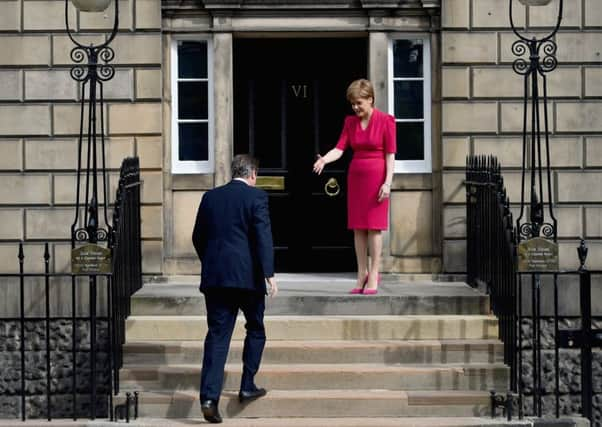Leaders: A worthy pledge – but SNP can go further


They make good soundbites ahead of election day but require a lot more detail in practice to become convincing. Can fine words be backed by action?
Today, the Scottish Government takes a step in that direction with its introduction of a gold standard for firms that commit to the Scottish Business Pledge. Companies that want to achieve this new status will have to pay the living wage to all workers over the age of 18 and sign up to two further commitments from a list of nine on a voluntary code designed to help create the fairer society we have heard so much about.
Advertisement
Hide AdAdvertisement
Hide AdEach firm that wants to wear this “badge of pride” also has to commit to achieving all elements of the code over time. There are other significant goals in the code, such as phasing out zero hours contracts and investing in young people.
The Deputy First Minister says this new partnership will promote “fairness, equality and sustainable economic growth”. Those words again. And what’s not to like, when it comes to ideals? Paying for them might be another matter, of course. CBI Scotland has warned not all businesses will be able to meet the code’s stated objectives and that individual circumstances should be taken into account.
One clear sign that the Scottish Government is on the right track is the political reaction to the introduction of the pledge. Labour’s Jackie Baillie says her party is behind any moves that promote the “living wage and fair work” in business, and she hopes the policy is successful. Meanwhile, the Conservatives’ enterprise spokesman, Murdo Fraser, describes the pledge as a “decent strategy” in principle.
However, both had criticisms to make. The Tories believe the gold standard lacks the necessary incentive to get firms to sign up, beyond simply gaining kudos. And Labour wants the measures to go further, to require private companies bidding for public contracts to pay the living wage.
These are decent points. The living wage is already a voluntary concept, and a recent poll estimated that only 20 per cent of Scotland’s leading employers have signed up. It may require more than the right to wear a badge of honour to get others over the line.
But it is on the issue of private companies bidding for public contracts where the policy could be stronger.
This is where the Scottish Government has the power to make a difference and bring about what could be a watershed moment. Scotland spends £10 billion per year on public contracts. If the Nationalists seek economic levers, there is one right here.
The art of the matter
THERE is a fine balance to be struck when it comes to self-promotion in Scotland. We tend to adopt extremes: depending on our mood, we are either convinced we are irrelevant, or we rather over-inflate the importance of our contribution to the development of mankind. From Mark Renton’s withering assessment of being Scottish in Trainspotting, to Jack McConnell’s “best small country in the world” – and with few stop-offs in between.
Advertisement
Hide AdAdvertisement
Hide AdAs always, the truth lies somewhere in between, but, in certain areas, Scotland can rightly be proud of a reputation that merits international recognition. One such field is highlighted in a new book by Sir John Leighton, 100 Masterpieces, featuring works assembled in Scotland’s national art collection.
The selected items are not necessarily Scottish; each is included because it is held in Scotland, thus illustrating the wealth of art to be admired here. Hence, there is only one Colourist on the list, but alongside Cadell are Rembrandt, Van Gogh, Monet, Raphael, Botticelli and Warhol. It’s a collection any national gallery would covet.
Most of us would be forced to admit we have taken the chance to see only a handful of these exhibits. Yet when we visit Madrid, we will go that extra mile to see Guernica, or when in Paris, head to the Louvre to see the Mona Lisa. It is easy to forget that works by Picasso and Leonardo da Vinci can be seen right here in Scotland.
It is important that we cherish, understand and appreciate the artwork on our own doorstep, for the benefit of future generations as well as for our own enjoyment. Sir John’s new book can help remind us of just what we are missing – right under our noses.